RBV(资源基础理论)的经典文献及摘要
RBV观点与动态能力对比分析

RBV观点与动态能力对比分析[摘要]本文搜集了有关RBV理论和动态能力观点比较有代表性的文献,通过对文献的整理和理解,分别从定义、假设和适用条件、主要内容三个角度将这两种观点进行了对比,最后提出对可持续竞争优势能否获得的看法。
[关键词]RBV;动态能力;可持续竞争优势1 引言自从Penrose(1959)首次提出RBV理论以来,经过后来学者的不断完善与发展,RBV理论已经被越来越多的学者接受,但是随着当今环境变化越来越剧烈,也有很多的学者对可持续竞争力能否获得和保持表示质疑。
动态能力的观点就比较有代表性,这种观点虽然最早可以追溯到熊彼特,但是在最近才得到重视与发展,如Dosi,Teece和Winter,1989;Prahalad和Hamel,1990;Porter,1990;Kathleen和Jeffrey,2000等,本文搜集了有关RBV理论和动态能力观点比较有代表性的文献,通过对文献的整理和理解,分别从定义、假设和适用条件、主要内容三个角度将这两种观点进行了对比,最后提出对可持续竞争优势能否获得的看法。
2 定义对比2.1 RBV观点的主要内容RBV观点将公司视为一系列资源的组合,公司的竞争优势来源于公司所特有、稀缺和难以模仿的资源,包括物理资本、人力资本和组织资本等。
由于路径依赖、社会复杂性和因果模糊性等原因,这些构成公司竞争优势的特有资源很难被竞争对手所获得,因而有可能成为公司的可持续的竞争优势的来源。
而判断公司的资源能否成为可持续竞争优势的来源有以下几个判断标准:资源是否有价值,资源是否是稀缺的,资源是否可模仿以及该资源是否容易被替代,同时满足以上四条的资源就可以成为可持续竞争优势的来源(Barney,1991)。
2.2 动态能力观点的主要内容动态能力的观点有很多种不同的版本,Teece,Pisano和Shuen(1997)认为动态能力就是公司为了适应动态的环境而发展出的整合、建立和重新建立内部和外部竞争优势的能力,管理和组织的流程决定了公司的竞争优势,而资源定位和路径共同影响流程并与流程共同构成了决定企业竞争优势的因素。
(完整版)关于资源基础理论的相关论述
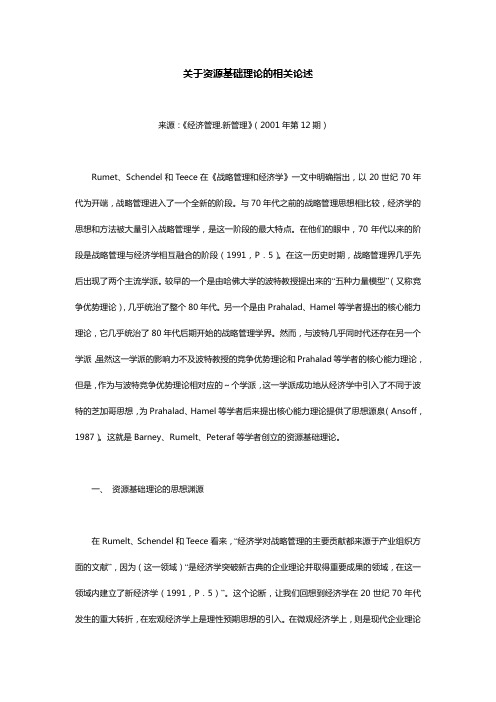
关于资源基础理论的相关论述来源:《经济管理.新管理》(2001年第12期)Rumet、Schendel和Teece在《战略管理和经济学》一文中明确指出,以20世纪70年代为开端,战略管理进入了一个全新的阶段。
与70年代之前的战略管理思想相比较,经济学的思想和方法被大量引入战略管理学,是这一阶段的最大特点。
在他们的眼中,70年代以来的阶段是战略管理与经济学相互融合的阶段(1991,P.5)。
在这一历史时期,战略管理界几乎先后出现了两个主流学派。
较早的一个是由哈佛大学的波特教授提出来的“五种力量模型”(又称竞争优势理论),几乎统治了整个80年代。
另一个是由Prahalad、Hamel等学者提出的核心能力理论,它几乎统治了80年代后期开始的战略管理学界。
然而,与波特几乎同时代还存在另一个学派,虽然这一学派的影响力不及波特教授的竞争优势理论和Prahalad等学者的核心能力理论,但是,作为与波特竞争优势理论相对应的~个学派,这一学派成功地从经济学中引入了不同于波特的芝加哥思想,为Prahalad、Hamel等学者后来提出核心能力理论提供了思想源泉(Ansoff,1987)。
这就是Barney、Rumelt、Peteraf等学者创立的资源基础理论。
一、资源基础理论的思想渊源在Rumelt、Schendel和Teece看来,“经济学对战略管理的主要贡献都来源于产业组织方面的文献”,因为(这一领域)“是经济学突破新古典的企业理论并取得重要成果的领域,在这一领域内建立了新经济学(1991,P.5)”。
这个论断,让我们回想到经济学在20世纪70年代发生的重大转折,在宏观经济学上是理性预期思想的引入。
在微观经济学上,则是现代企业理论与信息经济学的发展。
其中,与战略管理联系最密切的就是现代企业理论。
现代企业理论在思想上最大的特点就是放弃了新古典企业理论中同质性企业的假设,转而接受了差异性企业的现实,并试图用经济学的方法对这种差异给出有力的解释。
运用RBV之分析企业衰退期战略选择

摘要本文运用RBV(Resource--basedViewoftheFirm)分析企业面临衰退时所应采取的战略。
本文对企业衰退期概念作了界定,对企业衰退期和产业衰退作了区分,文中介绍了RBV的主要观点,采用RBV模式分析了企业面临衰退的原因,并对迈克尔·波特使甩SCP模式褥出的衰退产业中的企业战略提出了不同意见。
根据造成企业面临衰退的因素,本文提出了企业摆脱衰退的短期和长期战略。
根据RBV模式,借鉴博弈论的理论,本文推导出企业应采用短期战略和长期战略结合的方式摆脱衰退困境:短期内,企业主要采用战略调整是建立在企业现有战略资源基础上的营销创新等低成本战略;长期内,企业应进行战略创新,增加新的战略资源和提升组织创新、优化配置资源的能力,建立起企业持续竞争优势,从根本上摆脱衰退困境。
本文运用RBV模式对战略创新进行了新的探讨,讨论了战略创新的三个基本要素:基于资源的顾客价值观、基于资源和能力的技术创新战略和基于资源的组织创新能力。
最后,本文认为战略创新应通过四个层面的模式实现:1、基于企业资源优化配置的目的,退出某些不具有优势的业务;2、基于能力的流程再造(能力就是使组织具有竞争优势的业务流程);3、基于资源和能力的相关多元化,认为应根据企业战略资源和能力的相关性迸行多元化延伸:4、培育新的核心竞争力,刨造全新的产业,成为新产业的规则制定者,使企业最大限度地获得战略资源所仓U造的价值。
关键词:RBV企业衰退期衰退战略AbstractT11iStextUSeSRBV(Resource-basedViewoftheFirm)toanalyzethestrategythatenterprisesshouldadoptwhilefacingdeclining.Thetextdefinetheconceptofenterprisedeclineanddistinguishthefacttoactastoindustrydeclineandenterprisedecline.ItintroducethemainviewofRBVandadoptRBVmodetoanalyzethereasonthatenterprisesdecline.ComparetoMichael’PotteruseSCPmode,itdrawdifferentsuggestionsofthedeclinestrategytoenterprises.Accordingtothefactorcausingenterprisestodecline,thistexthasproposedthatenterpriseShouldadoptshorttimeandlong-termdecliningstrategytobreakawayfromthepredicamentofdeclining.AccordingtoRBVmode.drawlessonsfromthetheoryofgametheory,thistextsuggestthat:adoptstrategicadjustmentinashorttime,andadoptstrategytoinnovateforalongtime.Inashorttime,theenterprisesshouldmainlyadoptthestrategysuchasmarketinnovatingwhichset叩onthebasisofstrategicreSOUrcesofenterprises.Inbeinglong-term,enterpriseshouldcarryonstrategyinnovate,increasenewstrategicresourceanditsorganizing,distributingabilityofresourcerationallytopromotetosetupenterprisesandcompetefortheadvantagecontinuously,ThiSgoalofthestrate:gicinnovateiSthatenterprisescanbreakawayfromthepredicamentofdecliningcompletely.ThistextUSeSRBVmodetoinnovatenewdiscussiontostrategy,anddiscussthreebasickeyelementsthatstrategyinnovates:Basedonresourcecustomervalues.basedonresoUrceandabilit-/tectmologicaiinnovationstrategyandbasedonresourceinnovationabilityoforganizing.Finally,thistextthinksthatstrategyinnovatesandshouldberealizedthroughthemedeoffouraspects:l,Onthebasisofthepurposeofenterprise+Srcsoul℃erationaldistdbution,withdrawfromsomebusinessnothavingtheadvantage;2procedurebasedonabilityisgivenanewleaseoflifeto,abilityistoenableorganizingthebusinessprocedurevdthcompetitionadvantage;3.OnthebasisofresoUrcetsandability’Spluralismofdependence.iSitshouldgoondependenceextendaccordingtoenterprisestrategicresoUrceandabilityinplUralismtothink;4fostersthenewkeycompetitiveness,createthenewindustry.Iftheformulationofthenewindustryrulemakeenterprisesobtainpersonwhobecomesvaluethatthestrategicresourcecreatestothemaxim啪extent.Keywords:RBVEnterprisedeclinetimeDeclinestrategy.咝望查兰塑圭塑窒生兰焦堡壅笺!墨——_—————————‘--————●--——_—————^_————————●—_●—-——●——_————I●——一一第1章绪论自然界中的幸存者不是最强悍的物种,也不是最智慧的物种,而是那些最能应对变化的物种。
RBV回顾(资源基础理论的系统梳理)

(一)理论溯源:理论发展(2)
3.Barney, J.B. 1986. “Strategic Factor Markets: Expectations, Luck, and Business Strategy.” Management Science 32:1231-1241. 引入“战略性要素市场”:企业获取或培育其实施产品市场 战略所需资源的场所。“The ability to create imperfectly competitive product markets also depends on the cost of implementing the strategy” 如果战略要素 市场是完全竞争的,那么,在这些市场中对资源的获取 将会反映该资源用于实施产品市场战略时所能够创造的 绩效。如果战略性要素市场总是完全竞争的,企业则不 可能获得经济租。 (对 Porter研究的质疑) 获取经济租之所需资源两种途径:(1) Fortune and luck; (2)More accurate expectations(unusual insights about the future value of the resources) 企业已控资源比其他类型的资源更可能成为经济租来源。
解释企业为何存在,并聚焦于企业获取经济租的能力。探究了企业的寻租和配 租特性。将寻租理论、交易成本理论及随后出现的治理理论联系起来,致 力于发展一种企业的基于资源或基于知识的理论。将企业定义为一串生产 性资源束,且这些资源的价值将会依其应用情境变化而变化。他强调,这 些资源的可模仿性取决于它们被“隔绝机制”所保护的程度。甚至还提出 了一系列的隔绝机制并开始探讨那些能够增强不可模仿性的资源属性。
1.理论基础:特质能力理论(1)
企业核心竞争力的文献综述
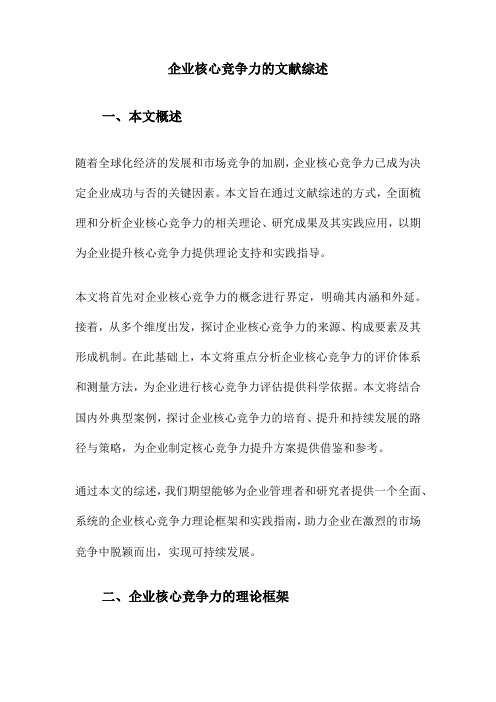
企业核心竞争力的文献综述一、本文概述随着全球化经济的发展和市场竞争的加剧,企业核心竞争力已成为决定企业成功与否的关键因素。
本文旨在通过文献综述的方式,全面梳理和分析企业核心竞争力的相关理论、研究成果及其实践应用,以期为企业提升核心竞争力提供理论支持和实践指导。
本文将首先对企业核心竞争力的概念进行界定,明确其内涵和外延。
接着,从多个维度出发,探讨企业核心竞争力的来源、构成要素及其形成机制。
在此基础上,本文将重点分析企业核心竞争力的评价体系和测量方法,为企业进行核心竞争力评估提供科学依据。
本文将结合国内外典型案例,探讨企业核心竞争力的培育、提升和持续发展的路径与策略,为企业制定核心竞争力提升方案提供借鉴和参考。
通过本文的综述,我们期望能够为企业管理者和研究者提供一个全面、系统的企业核心竞争力理论框架和实践指南,助力企业在激烈的市场竞争中脱颖而出,实现可持续发展。
二、企业核心竞争力的理论框架企业核心竞争力的概念自提出以来,就受到了理论界和实务界的广泛关注。
对于其核心理论框架的探讨,涉及到了多个学科领域,包括战略管理、创新管理、组织行为学等。
这些理论框架试图从不同角度解析企业核心竞争力的来源、构成、发展及其对企业持续竞争优势的影响。
核心竞争力来源的理论框架主要关注企业如何形成和维持其核心竞争力。
其中,资源基础观(Resource-Based View, RBV)认为,企业拥有的独特、稀缺、不可模仿和不可替代的资源是形成核心竞争力的关键。
知识基础观(Knowledge-Based View, KBV)则强调知识、尤其是隐性知识在构建核心竞争力中的作用。
动态能力理论(Dynamic Capabilities Theory)则进一步指出,企业在面对环境变化时,通过整合、构建和重构内外部资源的能力,是形成和维持核心竞争力的关键。
核心竞争力构成的理论框架主要探讨核心竞争力的具体构成要素。
这些要素通常包括技术能力、管理能力、市场营销能力、企业文化等。
4 资源基础观的理论发展
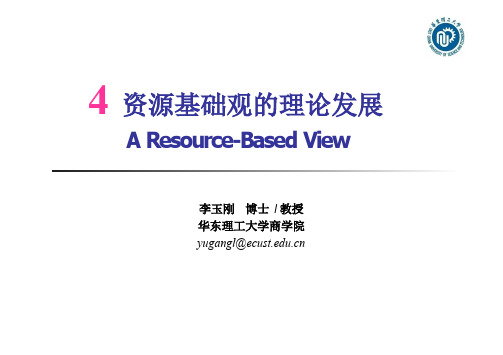
4资源基础观的理论发展A Resource-Based View李玉刚博士 / 教授华东理工大学商学院yugangl@资源基础观要回答的问题⏹同行业不同企业的绩效为何长期不同?⏹对企业内部资源和核心竞争力的分析,现在一般称为资源基础学派(RBS,Resource-based school)或资源基础观点( RBV,Resource-based View )Ansoff和Andrew s⏹在战略研究中,对企业内部的优势和劣势的分析和评估作为战略制定的前提⏹Andrew s (1971) : "an internal appraisal of strengths and w eaknesses, led to identification of distinctive competencies."⏹Ansoff (1965) : synergy as "one internally generated by a combination of capabilities or competencies“⏹对企业内部因素的研究并没有深入展开资源基础的早期渊源⏹对企业内部资源和核心竞争力的分析,现在一般称为资源基础学派(RBS,Resource-based school)或资源基础观点( RBV,Resource-based View )⏹早期的三个来源⏹与众不同的竞争力理论⏹李嘉图(Ricardo,1817)的经济学⏹彭罗斯的企业成长理论与众不同的竞争力/总经理distinctive competence⏹1911年,在哈佛大学,分析组织中的总经理角色⏹总经理和企业的绩效之间的关系⏹高质量的总经理是企业的优势,低质量的总经理是企业的劣势⏹方法的局限性⏹总经理“高质”的品质和特性模棱两可⏹并不是企业优势的唯一来源与众不同的竞争力/制度性的领导能力distinctive competence⏹社会学家塞尔兹尼克 Selznick⏹制度性的领导者(constitutional leaders)⏹确保企业与众不同的价值和身份——企业与众不同的愿景租金理论⏹李嘉图(David Richardo )关注“最初的、不可扩大的、不可破坏的天赋因素”的经济结果⏹土地的总供给相对固定,供给弹性低⏹那些拥有无供给弹性的高质量生产要素的人可能获得经济租金(高于正常的经济绩效)⏹企业使用的许多资源是没有供给弹性的,并且这些资源可能成为经济租金的源泉彭罗斯的企业成长理论⏹Penrose(1959) :theory of the growth of the firm ⏹从两方面理解企业⏹企业是一个由个体和群体活动组成的行政结构⏹企业是一组生产资源⏹经理人的任务⏹通过企业已经创造的行政结构,来利用企业控制的生产资源⏹彭罗斯的研究发现⏹企业所控制的生产性资源本质上是异质的⏹将异质的资源拓展到了管理团队、高层管理人员,以及企业家技巧之类的不具备弹性的生产性资源经济学对企业专有资源的关注 企业资源理论的原始思想由来已久。
一种面向供应链治理的知识共享学习模型

一种面向供应链治理的知识共享学习模型文/唐泽威1蒋诚智2(1.南京大学工程管理学院,江苏南京210093;2.南京工程学院经济与管理学院,江苏南京211167)[摘要]供应链治理的基本目标之一是激励成员之间的协作,以提升供应链整体绩效。
互相合作的供应链成员之间可以通过知识共享而获得自身本没有的经验,从而提高为顾客提供优质产品和服务的能力。
供应链成员之间的知识管理与共享在供应链治理中起着重要的作用,并在一定程度上有利于提高供应链治理水平。
本文提出了一种供应链企业知识与经验管理、共享的合作学习机制,并用Agent技术构建了知识库结构以及知识建构、获取、转换和积累的学习过程。
本文建立了电力企业中管理信息系统供应链信息安全知识管理模型,并研究了合作学习机制。
此模型可以为供应链成员之间建立有效知识共享机制提供有益的参考。
[关键词]合作学习Agent供应链治理[作者简介]唐泽威,南京大学工程管理学院博士研究生,助理研究员,研究方向为管理科学与工程;蒋诚智,南京工程学院经济与管理学院,博士,高级工程师,研究方向为信息管理与信息系统。
[中图分类号]C931[文献彌码]A[文章编号]1008-7672(2020)04-0101-09一、引言供应链治理的目的是搭建一个协调框架,其基本目标包括激励成员之间的协作以及协调供应链各方的利益,以创造尽量大的供应链价值和实现供应链企业的长期利益。
①现有研究将供应链治理机①陈正林:《论供应链的治理机制及其完善对策》,《湖北社会科学》2014年第11期。
101■治理前沿224fr w4轄W35褓竦wo—k 欝详莎翠<奇02制划分为利益分享机制和关系协调机制。
①在关系协调机制中,信息共享机制是协调供应链的一个重 要手段,通过促进供应链企业之间沟通和合作,可以增强供应链的凝聚力。
在供应链治理机制与供应 链绩效相互关系的研究方面,通过构建两者相互作用的关系模型,研究了社会控制、正式控制、信息 共享等和供应链绩效之间的相关关系,发现信息共享对供应链绩效产生正向影响,并且信息共享在 社会控制和供应链绩效的作用关系中起着部分中介的作用。
RBV回顾(资源基础理论的系统梳理)

1.理论基础:李嘉图学派经济学(2)
李嘉图经济租和不同层级肥力土地的经济效果
1.理论基础:李嘉图学派经济学(3)
对这种持久的绩效优势的威胁(租金耗散) a.市场需求向左下方移动; b.某些低成本的方式来提高其土地的肥力,从而
减少拥有较肥沃土地企业的绩效优势。
D1 MC
S p* p** D
AC
MC AC
1.理论基础:李嘉图学派经济学(1)
“原始的、不可扩增的和不可毁灭的源自自然的馈 赠”相关的经济结果(Ricardo, 1817) “original, unaugmentable, and indestructible gifts of Nature”; 经济租(economic rents ):某种生产要素的所有 者获得的超过诱使这种要素进入生产过程所需的 最小支付额的部分。(Hirshleifer,1980)
RBV:缘起、释义与启示
(Origins and Implications)
报告内容
理论溯源
基本架构 实证研究 研究展望
一、理论溯源
“为什么一些企业的绩效总是胜过其 他企业?”(持久卓越绩效从何而来) Why do some firms persistently outperform others?
(一)理论溯源:理论发展(3)
4.Barney, J. 1991. “Firm Resources and Sustained Competitive Advantage.” Journal of Management 17(1):99-120. 5.Dierickx, I. and K. Cool 1989. “Asset Stock Accumulation and Sustainability of Competitive Advantage.” Management Science 35:1504-1511. 6.Conner, K. 1991. “An Historical Comparison of Resource-based Logic and Five Schools of Thought within Industrial Organization Economies: Do We Have a New Theory of the Firm Here?” Journal of Management 17:121-154 (especially 132 to 150). 7.Peteraf, M.A. 1993. “The Cornerstones of Competitive Advantage: A Resource-based View.” Strategic Management Journal 14:179-192. 8.Teece, D. J, G. Pisano and A. Shuen. 1997. “Dynamic Capabilities and Strategic Management.” Strategic Management Journal, 18, 7, 509533.
资源基础观理论
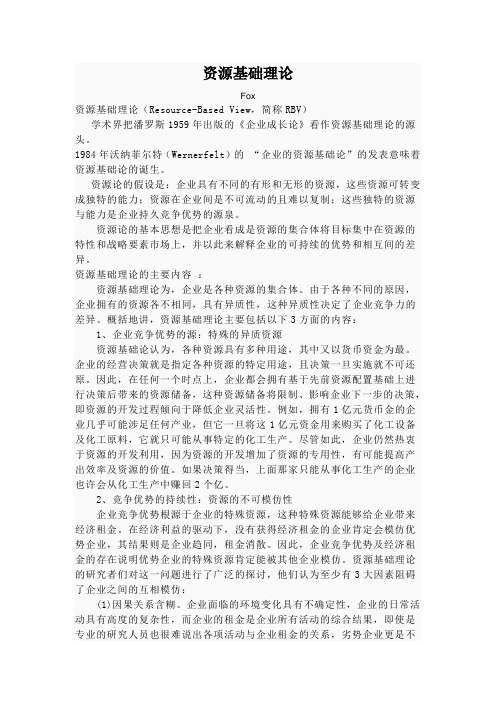
资源基础理论Fox资源基础理论(Resource-Based View,简称RBV)学术界把潘罗斯1959年出版的《企业成长论》看作资源基础理论的源头。
1984年沃纳菲尔特(Wernerfelt)的“企业的资源基础论”的发表意味着资源基础论的诞生。
资源论的假设是:企业具有不同的有形和无形的资源,这些资源可转变成独特的能力;资源在企业间是不可流动的且难以复制;这些独特的资源与能力是企业持久竞争优势的源泉。
资源论的基本思想是把企业看成是资源的集合体将目标集中在资源的特性和战略要素市场上,并以此来解释企业的可持续的优势和相互间的差异。
资源基础理论的主要内容:资源基础理论为,企业是各种资源的集合体。
由于各种不同的原因,企业拥有的资源各不相同,具有异质性,这种异质性决定了企业竞争力的差异。
概括地讲,资源基础理论主要包括以下3方面的内容:1、企业竞争优势的源:特殊的异质资源资源基础论认为,各种资源具有多种用途,其中又以货币资金为最。
企业的经营决策就是指定各种资源的特定用途,且决策一旦实施就不可还原。
因此,在任何一个时点上,企业都会拥有基于先前资源配置基础上进行决策后带来的资源储备,这种资源储备将限制、影响企业下一步的决策,即资源的开发过程倾向于降低企业灵活性。
例如,拥有1亿元货币金的企业几乎可能涉足任何产业,但它一旦将这1亿元资金用来购买了化工设备及化工原料,它就只可能从事特定的化工生产。
尽管如此,企业仍然热衷于资源的开发利用,因为资源的开发增加了资源的专用性,有可能提高产出效率及资源的价值。
如果决策得当,上面那家只能从事化工生产的企业也许会从化工生产中赚回2个亿。
2、竞争优势的持续性:资源的不可模仿性企业竞争优势根源于企业的特殊资源,这种特殊资源能够给企业带来经济租金。
在经济利益的驱动下,没有获得经济租金的企业肯定会模仿优势企业,其结果则是企业趋同,租金消散。
因此,企业竞争优势及经济租金的存在说明优势企业的特殊资源肯定能被其他企业模仿。
基于rbv理论的中小企业营销诊断

基于rbv理论的中小
03
企业营销诊断模型
构建
rbv理论在中小企业营销诊断中的应用
RBV理论强调以客户为中心的观念,在中小企业营销诊断中,需要分析客户的需 求和偏好,了解市场竞争状况,确定企业的核心竞争力和市场定位。
根据RBV理论,中小企业需要关注产品的功能性和情感性,加强与客户之间的互 动和沟通,建立良好的客户关系。
实施方案并跟踪效果
将解决方案付诸实施,并定期跟踪实施效 果,根据效果进行调整和优化。
进行市场调研
收集与诊断目标相关的市场数据和信息, 包括竞争对手、消费者需求、行业趋势等 。
制定解决方案
针对分析出的问题,制定相应的解决方案 ,包括改进产品、优化渠道策略、提升品 牌形象等。
分析问题
根据市场调研结果,分析中小企业营销活 动中存在的问题。
基于rbv理论的中小企业营销诊断模型框架
基于RBV理论的中小企业营销诊断模 型框架包括三个维度:客户价值、市 场竞争和企业的核心竞争力。
市场竞争维度包括竞争对手的产品特 性、价格策略和市场占有率等。
客户价值维度包括客户对产品的功能 性需求、情感性需求以及价格敏感度 等。
企业核心竞争力维度包括企业的研发 能力、生产能力、品牌影响力等。
营销效果。
增强竞争力
准确的营销诊断可以帮助中小企业 更好地了解市场需求和竞争状况, 从而制定更有效的营销策略,增强 竞争力。
促进企业发展
有效的营销诊断可以发现市场机会 ,提出具有前瞻性的建议,从而促 进中小企业的持续发展。
中小企业营销诊断的步骤
确定诊断目标
首先需要明确营销诊断的目标,例如提高 市场份额、促进产品销售等。
详细描述
1. 成本导向定价:根 据产品的成本、市场 需求以及竞争状况, 制定具有竞争力的价 格策略。
《战略资源与竞争优势:基于RBV理论的应用》
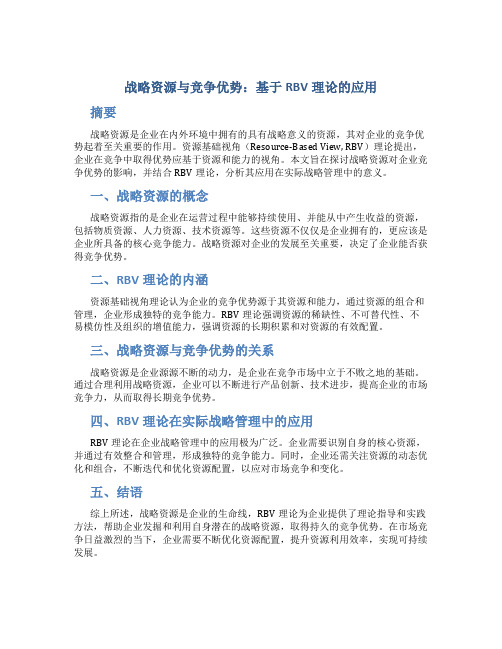
战略资源与竞争优势:基于RBV理论的应用摘要战略资源是企业在内外环境中拥有的具有战略意义的资源,其对企业的竞争优势起着至关重要的作用。
资源基础视角(Resource-Based View, RBV)理论提出,企业在竞争中取得优势应基于资源和能力的视角。
本文旨在探讨战略资源对企业竞争优势的影响,并结合RBV理论,分析其应用在实际战略管理中的意义。
一、战略资源的概念战略资源指的是企业在运营过程中能够持续使用、并能从中产生收益的资源,包括物质资源、人力资源、技术资源等。
这些资源不仅仅是企业拥有的,更应该是企业所具备的核心竞争能力。
战略资源对企业的发展至关重要,决定了企业能否获得竞争优势。
二、RBV理论的内涵资源基础视角理论认为企业的竞争优势源于其资源和能力,通过资源的组合和管理,企业形成独特的竞争能力。
RBV理论强调资源的稀缺性、不可替代性、不易模仿性及组织的增值能力,强调资源的长期积累和对资源的有效配置。
三、战略资源与竞争优势的关系战略资源是企业源源不断的动力,是企业在竞争市场中立于不败之地的基础。
通过合理利用战略资源,企业可以不断进行产品创新、技术进步,提高企业的市场竞争力,从而取得长期竞争优势。
四、RBV理论在实际战略管理中的应用RBV理论在企业战略管理中的应用极为广泛。
企业需要识别自身的核心资源,并通过有效整合和管理,形成独特的竞争能力。
同时,企业还需关注资源的动态优化和组合,不断迭代和优化资源配置,以应对市场竞争和变化。
五、结语综上所述,战略资源是企业的生命线,RBV理论为企业提供了理论指导和实践方法,帮助企业发掘和利用自身潜在的战略资源,取得持久的竞争优势。
在市场竞争日益激烈的当下,企业需要不断优化资源配置,提升资源利用效率,实现可持续发展。
以上是本文关于。
基于资源基础理论的跨国公司人力资源战略研究

基于资源基础理论的跨国公司人力资源战略研究摘要:文章探讨资源基础理论、跨国公司人力资源管理战略和全球整合——当地反应框架三者的融合可能性。
资源基础理论说明资源有价值、稀缺、难以模仿、不可替代四方面属性时,该资源能对公司创造持久性竞争优势。
具备四个属性的人力资源在全球整合——当地反应框架上被分析时,能准确说明现在跨国公司人力资源管理的位置。
关键词:资源基础理论;跨国公司;人力资源管理;全球整合;当地反应一、引言随着经济全球化的发展,跨国公司在世界各地的经营也在不断增加,在世界经济发展中的地位不断提高。
人力资源作为影响跨国公司业绩的主要因素之一,受到人们广泛的关注。
对公司的发展做出贡献的人是公司的成本呢,还是公司的资源呢?根据资源基础理论(Resource-based View,简称RBV),作者认为人是公司的资源,对公司的发展起积极的作用。
本文分析RBV在人力资源战略实施中的应用、全球整合(Global Integration,GI)——当地反应(Local Responsiveness,LR)框架的演变过程,并探讨了三者融合的可能性。
二、资源基础理论1.资源基础理论的特点。
资源基础理论是从组织内部寻找组织竞争优势的一种理论。
该理论认为,任何一家组织都是资源与能力的独特组合,这些资源和能力是组织战略的基础,也是利润的重要来源。
公司不同时期表现的差异是由它们独特的资源与能力的组合所引起的,并非行业的结构特征所致。
一家公司可以不断获取不同的资源,发展独特的能力。
因此,同一行业内的企业并非都会拥有同样的战略资源和能力(Barney,1991;Boxall,1996)。
企业的资源分为有形资源和无形资源两种主要类型。
有形资源是指可见的、能量化的资产。
生产设备、工厂及正式的报告系统是有形资源。
无形资源是指那些根植于企业的历史、长期以来积累下来的资产,这些无形资源以一种独特的方式存在,因此非常不容易被竞争对手了解和模仿。
RBV(资源基础理论)的经典文献及摘要
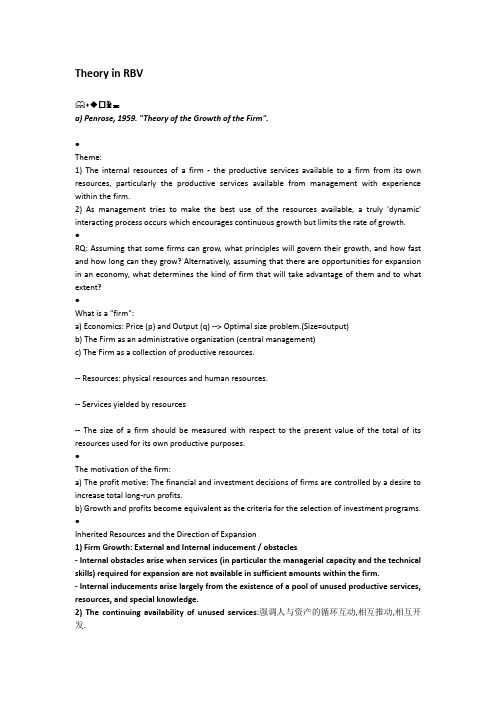
Theory in RBV♦◆☐a) Penrose, 1959. "Theory of the Growth of the Firm".●Theme:1) The internal resources of a firm - the productive services available to a firm from its own resources, particularly the productive services available from management with experience within the firm.2) As management tries to make the best use of the resources available, a truly 'dynamic' interacting process occurs which encourages continuous growth but limits the rate of growth.●RQ: Assuming that some firms can grow, what principles will govern their growth, and how fast and how long can they grow? Alternatively, assuming that there are opportunities for expansion in an economy, what determines the kind of firm that will take advantage of them and to what extent?●What is a "firm":a) Economics: Price (p) and Output (q) --> Optimal size problem.(Size=output)b) The Firm as an administrative organization (central management)c) The Firm as a collection of productive resources.-- Resources: physical resources and human resources.-- Services yielded by resources-- The size of a firm should be measured with respect to the present value of the total of its resources used for its own productive purposes.●The motivation of the firm:a) The profit motive: The financial and investment decisions of firms are controlled by a desire to increase total long-run profits.b) Growth and profits become equivalent as the criteria for the selection of investment programs.●Inherited Resources and the Direction of Expansion1) Firm Growth: External and Internal inducement / obstacles- Internal obstacles arise when services (in particular the managerial capacity and the technical skills) required for expansion are not available in sufficient amounts within the firm.- Internal inducements arise largely from the existence of a pool of unused productive services, resources, and special knowledge.2) The continuing availability of unused services:强调人与资产的循环互动,相互推动,相互开发.a) So long as any resources are not used fully in current operations, there is an incentive for a firm to find a way of using them more fully.b) No "equilibrium position"Indivisibility of resources: There's always unused servicesIn the process of utilizing unused services, new types of resources will always be added to the firm's collection of resources.c)'Idle' services and 'specialized' services: Specialization leads to higher common multiplies, higher common multiplies leads to greater specialization. -- Specialization --> Diversification --> Specialization......d) New services will also become available from existing resources.Interaction between personnel and material resources: Not only can the personnel of a firm render heterogeneous varieties of services, but also the material resources can be used in different ways, if the people who work with them get different ideas.e) The creation of new productive services. The services that resources will yield depend on the capacities of the men using them, but the development of the capacities of men is partly shaped by the resources men deal with.3) Demand and ResourcesDemand is a necessary condition of entrepreneurial interest in any product, but the original incentive to a great deal of innovation can be found in a firm's desire to use its existing resources more efficiently.4) The Direction of ExpansionNew combinations previously acquired or inherited resources and other resources which must be obtained from the market.♦◆☐b) Wernerfelt, 1984. "A Resource-Based View of the firm".●Theme: to look at firms in terms of resources rather than products; & Sequential entry.●Resource: anything which could be thought of as a strength or weakness of a given firm. Definition: Tangible or intangible assets which are tied semi-permanently to the firm.●1. Resource and profitability1) General effect: monopolistic bargaining power, substitution2) First Mover Advantage - Resource position barriers (VS. entry barrier- entry barrier是针对incumbent和potential entrants,未考虑diversifier.)3) Attractive resources (difficult for others to catch up)4) Mergers and Acquisitions: to trade otherwise non-marketable resources and to buy or sell resources in bundles.●2. Dynamic resource management1) The resource-product matrix2) Sequential entry - to develop the resource in one market and then to enter other markets from a position of strength.3) Exploit and develop - a balance between exploitation of existing resources and development of new ones.4) Stepping stones - diversification step must be evaluated in terms of short-term balance effect and long-term function as stepping stones to further expansion.c) Barney, 1986. "Strategic factor markets: expectations, luck and business strategy".●Theme: Above normal economic returns comes from more accurate expectations (originated from unique skills and capabilities) or luck from the strategic factor market.●1. Strategic factor markets: where firms buy and sell the resources necessary to implement their strategies.●2. Expectation and luck in strategic factor market●3. To obtain above normal returns: a) must be consistently better informed concerning the future value of those strategies; b) there are some ways to be better informed1) by analysis of competitive environment: less likely to systematically generate the expectation advantages because the methodologies for collecting this information and the conceptual models for analyzing it are in the public domain.2) by analysis of unique skill and capabilities: to analyze information about the assets a firm already controls but are not available to other firms (special manufacturing know-how, business experience, TMT...).♦◆☐d) Barney, 1991, "Firm Resources and Sustained Competitive Advantage".●Assumptions: Firms may be heterogeneous and resources may not be perfectly mobile.●Key concepts:-Firm Resource: include all assets, capabilities, organizational processes, firm attributes, information, knowledge, etc. (or, strengths) controlled by a firm that enable the firm to conceive of and implement strategies that improve its efficiency and effectiveness. (physical capital resources, human capital resources and organizational capital resources)-Sustained Competitive Advantage: 1) compared with current and potential competitors; 2) notduplicable by others; 3) not necessarily survive in Schumpeterian Shocks.●4 attributes of resources to have potential SCA:-Valuable-Rare-Imperfectly imitable: path dependent, causally ambiguity and socially complexity.-Non substitutable: substituted by similar resources or different strategic resources.♦◆☐ePriem and Butler, 2001. "Is the Resource-Based 'View' a useful perspective for strategic management research?"●1. RBV as a Theory? - lawlike generalizationa) Generalized conditionsb) Empirical context (tautology)c) Nomic necessity●2. An elemental fallacy of RBVThe 'value' attribute and environmental side●3. For strategy researcha) Operational validity and implement abilityb) RBV boundaries ( context)c) All-inclusive Resourcesd) The process from resource to SCAe) Static RBV - limitations (hard to evaluate resource, process black box, difficult to practice,...) ●4. Discussion:Formalizing RBV towards a theoryAnswering the How questionIncorporating the temporal component - path dependentIntegrating demand heterogeneity model♦◆☐f) Barney, 2001. 'Is RBV a useful perspective for strategic management research? Yes.' Admitting market-side consideration♦◆☐g) Amit and Schoemaker, 1993. "Strategic Assets and Organizational Rent".●RQ: How to identify, develop and deploy firm-specific Strategic Assets?●Main Contributions: Strategic assets and Strategic Industry Factors●Firm level - Strategic assets: the set off difficult to trade and imitate, scarce, appropriable and specialized Resources and Capabilities.●Market level - Strategic Industry Factors: Certain resources and capabilities that have become the prime determinants of economic rents. (ex post)●Problem: how to identify, ex ante, a set of Strategic Assets.●Multidimensional view:1) Industry Analysis: the focus is on rent distribution2) RBV: the focus is internal evolutionary path; trade-off between specialization and robustness3) Behavioral view: uncertainty, complexity, conflict. --> suboptimal♦◆☐f) Dierickx and Cool, 1989. "Asset stock accumulation and Sustainability of competitive advantage". (early dynamic RBV article)●Main points:-Critical resources that are imperfectly imitable are accumulated rather than acquired in strategic factor market (Barney, 1986). Asset accumulation process: time compression diseconomies, asset mass efficiencies, inter-connectedness, asset erosion and causal ambiguity.-Accumulation of asset stocks: the strategic asset stocks are accumulated by choosing appropriate time paths of flows over a period of time.-Strategic asset stocks: non-tradable, nonimitable and nonsubstitutableEmpirical in RBVA. Topic: Managerial Ability and firm performance♦◆☐Holcomb et. al, 2009. "Making the most of what you have: managerial ability as a source of resource value creation".●This article goes back to Penrose (1959)'s seminal work, investigating the effect of managerial ability on resource productivity, interacting with resource quality. There are 3 main contributions:1. Managerial ability is a potential source of value creation.2. Managerial ability interactive with resource quality influences value creation.3. The process of managerial ability to optimize firm performance -- synchronization of combinations of resource bundles.●Data source: football team.B. Topic: Non-scale free capabilities and diversification♦◆☐Levinthal and Wu, 2010. "Opportunitycosts and non-scale free capabilities: profit maximization, corporate scope, and profit margins".●This study provides an alternative explanation for diversification discount, which relies on an opportunity costs logic to distinguish between non-scale free and scale free capabilities, and also provides a rational explanation for the divergence between total profits and profit margins.1. RBV logic: The fungibility of resource is the basis for the explanation of related diversification. --> Assumption: scale free.2. Opportunity cost of resources --> non-scale free resources3. Market demand and resource allocation - Diversification is also impacted by the market opportunities: when the current industry becomes mature, firms make rational decisions to increase total profit (profit maximization) via diversification. However, firms need to allocate their non-scale free resources to new business, which may lead to lower average returns.4. Diversifying firms are 'good types' (i.e., high capabilities) operating in 'bad' market context. (i.e., generalist firm)C. Topic: Formality and SME performance♦◆☐Terziovski, 2010. "Innovation practice and its performance implications in small and medium enterprises (SEMs) in the manufacturing sector: a resource-based view."●Theory: Schumpeterian's two-phase innovation theory; the benefits of formality (efficiency) and informality (flexibility).●Results: innovation strategy and formal structure are positive predictors of SME performance.D. Mergers and Acquisitions♦◆☐a) Puranam and Srikanth, 2007. "What they know VS. What they do: how acquirers leverage technology acquisitions".●Theme: to reconcile the integration paradox - Leveraging what they know (learning) & Leveraging what they do (disruption).●Main effect: Post acquisition integration (structural integration/structural separation) --> the success of leveraging.●Moderating effect: acquisition experience●Logic: integration mechanism both enhances coordination and harm leveraging technology.●Arguments:1. Structural integration enhances the leveraging of knowledge via coordination effect.2. Structural integration harms the leveraging of capability (ongoing innovations of the acquired firm) via the decrease of autonomy.3. Acquisition experience of acquirer moderates the relationship.4. Some solutions of post acquisition: rich unstructured communication, in the form of frequent face-to-face interactions, acids the disruptive consequences of administrative and cultural integration while also enabling high levels of coordination.♦◆☐b) Larsson and Finkelstein, 1999. 'Integrating strategic, organizational, and human resource perspective on mergers and ac questions: a case survey of synergy realization'.●Arguments: Synergy realization is a function of the similarity and complementarity of two merging businesses (combination potential), the extent of interaction and coordination during the organizational integration process, and the lack of employee resistance the combined entry.♦◆☐c) Haunschild, 1994. "How much is that company worth?: Interorganizational relationship, uncertainty and acquisition premiums."- Network perspective●Arguments:1. Firm managers will look to both their interlock partners and professional firms when deciding how much to pay.2. The impact of interlocks and professional firms on the premium decision will be stronger when managers are uncertain about the value of the Acquisition target.♦◆☐d) Stearns and Allan, 1996. "Economic behavior in institutional environments: the corporate merger wave of the 1980s".-Network and institutional perspective●A model: First, economic and political changes create conditions for merger wave; second, challengers (marginal actors) who lack status and resources exploit these conditions; third, the methods of successful challengers are imitated through the business community.。
rbv 例子 -回复

rbv 例子-回复什么是资源基础理论(RBV)?资源基础理论(Resource-Based View, RBV)是一种管理学理论,旨在解释企业的核心竞争优势来自于其资源和能力的组合。
RBV着眼于企业内部资源的重要性,认为资源和能力是创造和维持竞争优势的基础。
通过有效地利用和整合资源,企业能够在市场上获得竞争优势。
RBV理论认为,资源是企业的核心竞争力,而这些资源往往是难以复制和替代的。
这些资源包括实物资源(例如设备、资产和基础设施)以及非实物资源(例如品牌声誉、专利、技术和人力资源)。
它们以特定的组合方式形成企业的核心能力,从而实现市场竞争优势。
由于资源的独特性,企业可以通过资源获取持续的竞争优势。
RBV强调资源的稀缺性和获取成本,认为企业应该专注于发展和扩大这些资源,而不是依赖于市场因素。
这种资源主导的策略有助于企业建立无可替代的竞争优势。
RBV理论的核心原则是企业必须拥有独特、价值和不易复制的资源和能力。
资源需要满足价值、稀缺性、且不易模仿这三个条件。
如果资源不满足这些条件,企业则难以在市场上获得持久的竞争优势。
在实践中,RBV理论可以用来帮助企业确定自身的核心竞争优势,并开展资源整合和管理。
企业需要评估其现有资源和能力,确定哪些是具有竞争优势的。
然后,企业可以通过投资和扩大这些资源来加强其竞争地位。
为了有效地利用资源,企业需要建立组织结构和系统以支持资源的管理和整合。
这包括确保资源在企业内部的协调、协作和配置,以及通过知识共享和技术创新来更新和发展资源。
RBV理论也提供了一种评估企业和行业的框架。
通过分析企业的资源和能力与竞争对手的比较,企业可以确定其在市场上的竞争地位,并制定相应的竞争战略。
虽然RBV理论在解释企业竞争优势方面提供了有价值的观点,但它也面临着一些挑战和批评。
其中一个主要的批评是RBV理论未能考虑外部环境因素对企业竞争力的影响。
此外,一些学者认为,RBV理论过于专注于资源的内部特征,而忽视了资源与市场需求之间的关系。
资源基础观英文介绍
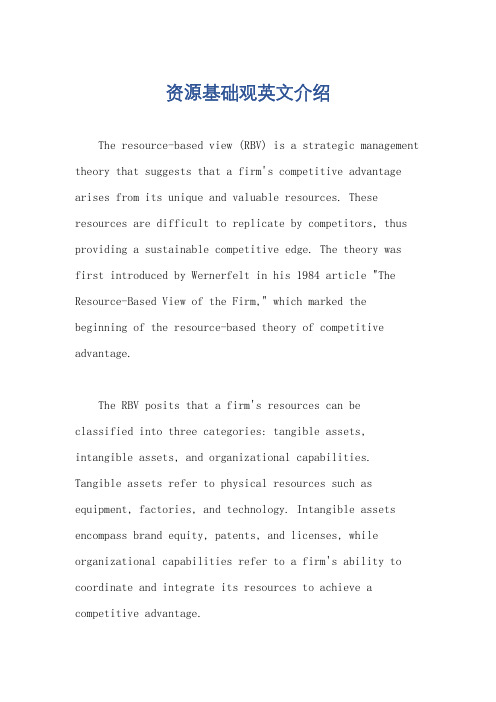
资源基础观英文介绍The resource-based view (RBV) is a strategic management theory that suggests that a firm's competitive advantage arises from its unique and valuable resources. These resources are difficult to replicate by competitors, thus providing a sustainable competitive edge. The theory was first introduced by Wernerfelt in his 1984 article "The Resource-Based View of the Firm," which marked the beginning of the resource-based theory of competitive advantage.The RBV posits that a firm's resources can beclassified into three categories: tangible assets, intangible assets, and organizational capabilities. Tangible assets refer to physical resources such as equipment, factories, and technology. Intangible assets encompass brand equity, patents, and licenses, while organizational capabilities refer to a firm's ability to coordinate and integrate its resources to achieve a competitive advantage.According to the RBV, the value of a firm's resources depends on their rarity, imitability, and substitutability. Resources that are rare and difficult to imitate are considered more valuable. Moreover, resources that are not easily substitutable by competitors also contribute to a firm's competitive advantage.The theory further suggests that a firm's competitive strategy should focus on leveraging its unique resources to create value for customers. By doing so, the firm can achieve above-average returns and maintain its competitive edge. To analyze a firm's resource position and develop strategic options, Wernerfelt proposed two economic tools: resource position barriers and the resource-product matrix.Resource position barriers refer to the obstacles that competitors face when trying to replicate a firm's unique resources. These barriers can arise from various factors such as legal protection, access to resources, and thefirm's ability to integrate its resources effectively. By identifying and strengthening these barriers, a firm canenhance its competitive advantage.The resource-product matrix is a tool that helps firms identify the products and services that can be developed using their unique resources. By mapping out the firm's resources and capabilities against potential products and services, managers can gain insights into which areas offer the greatest potential for competitive advantage.The RBV has since evolved and been applied in various contexts, including industry analysis, corporate strategy, and entrepreneurship. It has provided a valuable framework for understanding how firms can achieve and maintain competitive advantage through the effective management and development of their unique resources.In conclusion, the resource-based view offers a powerful theoretical framework for analyzing a firm's competitive advantage. By focusing on the unique resources and capabilities that are difficult to replicate by competitors, managers can develop strategies that leveragethese resources to create value for customers and maintain a sustainable competitive edge.。
企业资源基础理论中的人力资源

企业资源基础理论中的人力资源企业资源基础理论(resource-based view,RBV)是管理学者伯格·沃纳菲尔特于1984年正式提出的,其主要观点是,企业是一个资源集合体,企业所拥有或掌握的资源影响企业的竞争优势和收益水平,而企业成长战略的实质就是在运用现有的资源与培育新的资源之间寻求平衡。
资源基础理论标志着企业核心竞争力理论的兴起,它指出一个组织的竞争力并非来源于其所处的外部环境,而是来源于组织内部所具有的区分于其他组织的异质性资源。
换言之,企业要想获得持续的竞争力,必需对这些异质性资源进行投资、升级以及有效利用。
管理学者杰伊·巴尼则在1991年指出,组织绩效主要取决于三类重要的内部资源:物质资源、人力资源以及组织资源。
同时,他还明确提出了成为异质性资源所必需具备的四个特性(VRIN),即有价值性(valuable)、稀缺性(rare)、难以仿照性(imperfectly imitable)和难以替代性(non-substitutable),并且指出,这四种特征是这些异质性资源制造租金的基础,构成了企业竞争优势的内生来源。
而对于一家企业来说,人力资源恰恰比较简单具备这样四种异质性资源特征。
其一,人力资源是有价值的。
高素养的员工往往能够履行多种对于组织来说特别关键的职能,通过在生产产品、供应服务以及研发、销售等环节的工作为组织制造价值。
其二,人力资源是稀缺的。
具有组织需要的特定学问、技能和阅历,并且具有企业需要的人格特点、价值观和工作动机的核心员工或关键员工往往是很难找到的,企业可能要花费很长的时间甚至支付很高的费用,才能够发觉并吸引来符合自己要求的能够填补重要岗位的员工。
其三,人力资源是无法仿照的。
要想仿照一家高绩效组织的人力资源,首先要搞清晰究竟是哪些员工在为其带来竞争优势以及是如何带来竞争优势的,其次还要设法找到具有类似的学问、技能以及价值观等特征的员工,最终还要制造一种合适的组织环境来使这些员工的确能够为组织带来竞争优势。
rbv 例子 -回复

rbv 例子-回复以下是一篇以"[rbv 例子]"为主题的1500-2000字的文章,详细回答了与这个主题相关的问题。
[rbv 例子]是什么意思?这个问题可能让许多人感到困惑。
在营销和战略管理领域,RBV代表着资源基础视角(Resource-Based View)。
这个理论认为,企业的资源和能力是其竞争优势的根源。
这意味着企业应该利用和发展其独特的资源来获得持久的竞争优势。
为更好地理解RBV理论,我们将进行进一步讨论和详细的说明。
首先,资源基础视角认为企业的资源可以划分为有形和无形资源。
有形资源包括物理资产,例如生产设备和仓库。
无形资源则包括品牌声誉,专利技术和员工专业知识等。
无论是有形还是无形的资源,它们都与企业的战略和竞争力密切相关。
在这个视角下,资源被视为企业的核心要素,能够区别一个企业与其竞争对手。
其次,RBV强调资源的稀缺性和不可替代性。
稀缺资源是指在市场上有限供应的资源。
它们可以是非常昂贵和难以获取。
一个企业若拥有这样的稀缺资源,就能够获得竞争优势。
另外,一项资源如果是难以被其他企业模仿或替代的,也具备了一种战略上的价值。
这是因为,如果其他企业无法轻易获得相同的资源,那么这个资源将成为其竞争优势的来源。
另外,资源的组合和整合对于企业竞争力的发展也至关重要。
资源并非孤立存在的,而是通过各种方式和方法进行组合和整合。
通过将不同资源组合在一起,企业可以创造出更高的价值和效率。
例如,一个具有独特的产品设计和高效的生产设备的企业,可以通过整合这两个资源来生产高质量的产品,并为其竞争对手难以模仿。
因此,企业应该将资源整合视作战略规划的一部分,并以此为基础来发展竞争优势。
此外,资源的动态和可学习性也在RBV理论中被重视。
企业环境存在不断变化的因素,资源也应该能够适应这样的变化。
这需要企业进行不断的学习和调整,以适应新的市场需求和竞争条件。
正是通过不断学习和调整其资源组合,一个企业才能够持续地保持竞争优势。
- 1、下载文档前请自行甄别文档内容的完整性,平台不提供额外的编辑、内容补充、找答案等附加服务。
- 2、"仅部分预览"的文档,不可在线预览部分如存在完整性等问题,可反馈申请退款(可完整预览的文档不适用该条件!)。
- 3、如文档侵犯您的权益,请联系客服反馈,我们会尽快为您处理(人工客服工作时间:9:00-18:30)。
Theory in RBV♦◆☐a) Penrose, 1959. "Theory of the Growth of the Firm".●Theme:1) The internal resources of a firm - the productive services available to a firm from its own resources, particularly the productive services available from management with experience within the firm.2) As management tries to make the best use of the resources available, a truly 'dynamic' interacting process occurs which encourages continuous growth but limits the rate of growth.●RQ: Assuming that some firms can grow, what principles will govern their growth, and how fast and how long can they grow? Alternatively, assuming that there are opportunities for expansion in an economy, what determines the kind of firm that will take advantage of them and to what extent?●What is a "firm":a) Economics: Price (p) and Output (q) --> Optimal size problem.(Size=output)b) The Firm as an administrative organization (central management)c) The Firm as a collection of productive resources.-- Resources: physical resources and human resources.-- Services yielded by resources-- The size of a firm should be measured with respect to the present value of the total of its resources used for its own productive purposes.●The motivation of the firm:a) The profit motive: The financial and investment decisions of firms are controlled by a desire to increase total long-run profits.b) Growth and profits become equivalent as the criteria for the selection of investment programs.●Inherited Resources and the Direction of Expansion1) Firm Growth: External and Internal inducement / obstacles- Internal obstacles arise when services (in particular the managerial capacity and the technical skills) required for expansion are not available in sufficient amounts within the firm.- Internal inducements arise largely from the existence of a pool of unused productive services, resources, and special knowledge.2) The continuing availability of unused services:强调人与资产的循环互动,相互推动,相互开发.a) So long as any resources are not used fully in current operations, there is an incentive for a firm to find a way of using them more fully.b) No "equilibrium position"Indivisibility of resources: There's always unused servicesIn the process of utilizing unused services, new types of resources will always be added to the firm's collection of resources.c)'Idle' services and 'specialized' services: Specialization leads to higher common multiplies, higher common multiplies leads to greater specialization. -- Specialization --> Diversification --> Specialization......d) New services will also become available from existing resources.Interaction between personnel and material resources: Not only can the personnel of a firm render heterogeneous varieties of services, but also the material resources can be used in different ways, if the people who work with them get different ideas.e) The creation of new productive services. The services that resources will yield depend on the capacities of the men using them, but the development of the capacities of men is partly shaped by the resources men deal with.3) Demand and ResourcesDemand is a necessary condition of entrepreneurial interest in any product, but the original incentive to a great deal of innovation can be found in a firm's desire to use its existing resources more efficiently.4) The Direction of ExpansionNew combinations previously acquired or inherited resources and other resources which must be obtained from the market.♦◆☐b) Wernerfelt, 1984. "A Resource-Based View of the firm".●Theme: to look at firms in terms of resources rather than products; & Sequential entry.●Resource: anything which could be thought of as a strength or weakness of a given firm. Definition: Tangible or intangible assets which are tied semi-permanently to the firm.●1. Resource and profitability1) General effect: monopolistic bargaining power, substitution2) First Mover Advantage - Resource position barriers (VS. entry barrier- entry barrier是针对incumbent和potential entrants,未考虑diversifier.)3) Attractive resources (difficult for others to catch up)4) Mergers and Acquisitions: to trade otherwise non-marketable resources and to buy or sell resources in bundles.●2. Dynamic resource management1) The resource-product matrix2) Sequential entry - to develop the resource in one market and then to enter other markets from a position of strength.3) Exploit and develop - a balance between exploitation of existing resources and development of new ones.4) Stepping stones - diversification step must be evaluated in terms of short-term balance effect and long-term function as stepping stones to further expansion.c) Barney, 1986. "Strategic factor markets: expectations, luck and business strategy".●Theme: Above normal economic returns comes from more accurate expectations (originated from unique skills and capabilities) or luck from the strategic factor market.●1. Strategic factor markets: where firms buy and sell the resources necessary to implement their strategies.●2. Expectation and luck in strategic factor market●3. To obtain above normal returns: a) must be consistently better informed concerning the future value of those strategies; b) there are some ways to be better informed1) by analysis of competitive environment: less likely to systematically generate the expectation advantages because the methodologies for collecting this information and the conceptual models for analyzing it are in the public domain.2) by analysis of unique skill and capabilities: to analyze information about the assets a firm already controls but are not available to other firms (special manufacturing know-how, business experience, TMT...).♦◆☐d) Barney, 1991, "Firm Resources and Sustained Competitive Advantage".●Assumptions: Firms may be heterogeneous and resources may not be perfectly mobile.●Key concepts:-Firm Resource: include all assets, capabilities, organizational processes, firm attributes, information, knowledge, etc. (or, strengths) controlled by a firm that enable the firm to conceive of and implement strategies that improve its efficiency and effectiveness. (physical capital resources, human capital resources and organizational capital resources)-Sustained Competitive Advantage: 1) compared with current and potential competitors; 2) notduplicable by others; 3) not necessarily survive in Schumpeterian Shocks.●4 attributes of resources to have potential SCA:-Valuable-Rare-Imperfectly imitable: path dependent, causally ambiguity and socially complexity.-Non substitutable: substituted by similar resources or different strategic resources.♦◆☐ePriem and Butler, 2001. "Is the Resource-Based 'View' a useful perspective for strategic management research?"●1. RBV as a Theory? - lawlike generalizationa) Generalized conditionsb) Empirical context (tautology)c) Nomic necessity●2. An elemental fallacy of RBVThe 'value' attribute and environmental side●3. For strategy researcha) Operational validity and implement abilityb) RBV boundaries ( context)c) All-inclusive Resourcesd) The process from resource to SCAe) Static RBV - limitations (hard to evaluate resource, process black box, difficult to practice,...) ●4. Discussion:Formalizing RBV towards a theoryAnswering the How questionIncorporating the temporal component - path dependentIntegrating demand heterogeneity model♦◆☐f) Barney, 2001. 'Is RBV a useful perspective for strategic management research? Yes.' Admitting market-side consideration♦◆☐g) Amit and Schoemaker, 1993. "Strategic Assets and Organizational Rent".●RQ: How to identify, develop and deploy firm-specific Strategic Assets?●Main Contributions: Strategic assets and Strategic Industry Factors●Firm level - Strategic assets: the set off difficult to trade and imitate, scarce, appropriable and specialized Resources and Capabilities.●Market level - Strategic Industry Factors: Certain resources and capabilities that have become the prime determinants of economic rents. (ex post)●Problem: how to identify, ex ante, a set of Strategic Assets.●Multidimensional view:1) Industry Analysis: the focus is on rent distribution2) RBV: the focus is internal evolutionary path; trade-off between specialization and robustness3) Behavioral view: uncertainty, complexity, conflict. --> suboptimal♦◆☐f) Dierickx and Cool, 1989. "Asset stock accumulation and Sustainability of competitive advantage". (early dynamic RBV article)●Main points:-Critical resources that are imperfectly imitable are accumulated rather than acquired in strategic factor market (Barney, 1986). Asset accumulation process: time compression diseconomies, asset mass efficiencies, inter-connectedness, asset erosion and causal ambiguity.-Accumulation of asset stocks: the strategic asset stocks are accumulated by choosing appropriate time paths of flows over a period of time.-Strategic asset stocks: non-tradable, nonimitable and nonsubstitutableEmpirical in RBVA. Topic: Managerial Ability and firm performance♦◆☐Holcomb et. al, 2009. "Making the most of what you have: managerial ability as a source of resource value creation".●This article goes back to Penrose (1959)'s seminal work, investigating the effect of managerial ability on resource productivity, interacting with resource quality. There are 3 main contributions:1. Managerial ability is a potential source of value creation.2. Managerial ability interactive with resource quality influences value creation.3. The process of managerial ability to optimize firm performance -- synchronization of combinations of resource bundles.●Data source: football team.B. Topic: Non-scale free capabilities and diversification♦◆☐Levinthal and Wu, 2010. "Opportunitycosts and non-scale free capabilities: profit maximization, corporate scope, and profit margins".●This study provides an alternative explanation for diversification discount, which relies on an opportunity costs logic to distinguish between non-scale free and scale free capabilities, and also provides a rational explanation for the divergence between total profits and profit margins.1. RBV logic: The fungibility of resource is the basis for the explanation of related diversification. --> Assumption: scale free.2. Opportunity cost of resources --> non-scale free resources3. Market demand and resource allocation - Diversification is also impacted by the market opportunities: when the current industry becomes mature, firms make rational decisions to increase total profit (profit maximization) via diversification. However, firms need to allocate their non-scale free resources to new business, which may lead to lower average returns.4. Diversifying firms are 'good types' (i.e., high capabilities) operating in 'bad' market context. (i.e., generalist firm)C. Topic: Formality and SME performance♦◆☐Terziovski, 2010. "Innovation practice and its performance implications in small and medium enterprises (SEMs) in the manufacturing sector: a resource-based view."●Theory: Schumpeterian's two-phase innovation theory; the benefits of formality (efficiency) and informality (flexibility).●Results: innovation strategy and formal structure are positive predictors of SME performance.D. Mergers and Acquisitions♦◆☐a) Puranam and Srikanth, 2007. "What they know VS. What they do: how acquirers leverage technology acquisitions".●Theme: to reconcile the integration paradox - Leveraging what they know (learning) & Leveraging what they do (disruption).●Main effect: Post acquisition integration (structural integration/structural separation) --> the success of leveraging.●Moderating effect: acquisition experience●Logic: integration mechanism both enhances coordination and harm leveraging technology.●Arguments:1. Structural integration enhances the leveraging of knowledge via coordination effect.2. Structural integration harms the leveraging of capability (ongoing innovations of the acquired firm) via the decrease of autonomy.3. Acquisition experience of acquirer moderates the relationship.4. Some solutions of post acquisition: rich unstructured communication, in the form of frequent face-to-face interactions, acids the disruptive consequences of administrative and cultural integration while also enabling high levels of coordination.♦◆☐b) Larsson and Finkelstein, 1999. 'Integrating strategic, organizational, and human resource perspective on mergers and ac questions: a case survey of synergy realization'.●Arguments: Synergy realization is a function of the similarity and complementarity of two merging businesses (combination potential), the extent of interaction and coordination during the organizational integration process, and the lack of employee resistance the combined entry.♦◆☐c) Haunschild, 1994. "How much is that company worth?: Interorganizational relationship, uncertainty and acquisition premiums."- Network perspective●Arguments:1. Firm managers will look to both their interlock partners and professional firms when deciding how much to pay.2. The impact of interlocks and professional firms on the premium decision will be stronger when managers are uncertain about the value of the Acquisition target.♦◆☐d) Stearns and Allan, 1996. "Economic behavior in institutional environments: the corporate merger wave of the 1980s".-Network and institutional perspective●A model: First, economic and political changes create conditions for merger wave; second, challengers (marginal actors) who lack status and resources exploit these conditions; third, the methods of successful challengers are imitated through the business community.。

